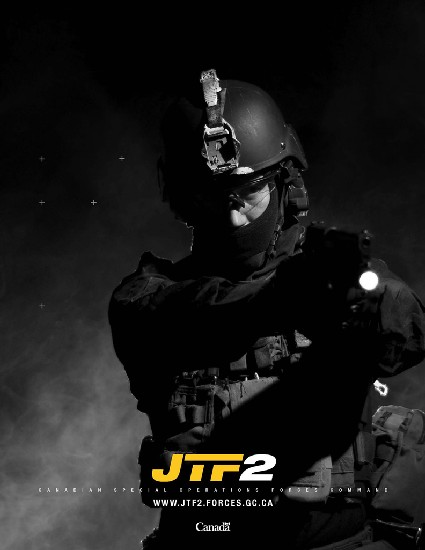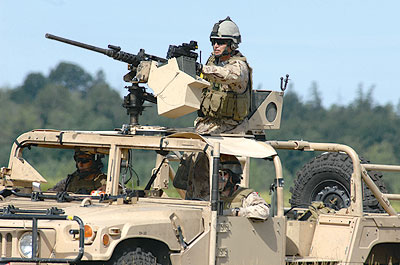
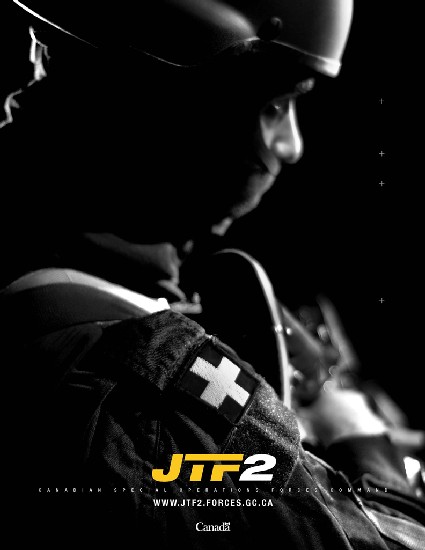
.
In 1992, Minister of Defence Robert Fowler announced he was disbanding the SERT police unit and creating a new military counter-terrorism group. The decision was made largely because the Canadian Forces offered better-trained recruits for the program than civilian police forces, and it stemmed the public uproar about police being taught to use primarily lethal means.[2]
In early 1993, the unit was activated with just over 100 members, primarily drawn from the Canadian Airborne Regiment and PPCLI.[2] They were given the SERT facility on Dwyer Hill Road in Ottawa as their own base of operations, and permanently parked a Greyhound bus and a DC-9 aircraft on the grounds for use in training.[2]
Its first scheduled action was Operation Campus, the protection of highways and water treatment plants around the Oka reserve while a police force tried to "crack down on smuggling" on the native reserve, immediately following the Oka crisis. However two daily newspapers in Quebec revealed the operation just days before it was to go into action, and it was canceled.[2]
The federal budget of December 2001 allocated approximately $120 million over six years to expand unit capabilities and double its size to an estimated 600 forces, as part of the overall plan following the attacks of 11 September 2001.
In 1992, Minister of Defence Robert Fowler announced he was disbanding the SERT police unit and creating a new military counter-terrorism group. The decision was made largely because the Canadian Forces offered better-trained recruits for the program than civilian police forces, and it stemmed the public uproar about police being taught to use primarily lethal means.[2]
In early 1993, the unit was activated with just over 100 members, primarily drawn from the Canadian Airborne Regiment and PPCLI.[2] They were given the SERT facility on Dwyer Hill Road in Ottawa as their own base of operations, and permanently parked a Greyhound bus and a DC-9 aircraft on the grounds for use in training.[2]
Its first scheduled action was Operation Campus, the protection of highways and water treatment plants around the Oka reserve while a police force tried to "crack down on smuggling" on the native reserve, immediately following the Oka crisis. However two daily newspapers in Quebec revealed the operation just days before it was to go into action, and it was canceled.[2]
The federal budget of December 2001 allocated approximately $120 million over six years to expand unit capabilities and double its size to an estimated 600 forces, as part of the overall plan following the attacks of 11 September 2001.
History of the unit
Support and specialist members selection process
Candidates for the specialists and support roles also go through a selection process, however, there are differences compared to the selection process for assaulter candidates. The main difference is that they do not have to take the seven-month SOAC. In Phase I candidates submit their applications through their unit's chain of command. During Phase II, the candidate must successfully complete the CF Expres Test or Specialist Physical Fitness Test, however, they do not have to complete the CF Swim Test and the screening process is done at a later phase than in the assaulters application process. In Phase III the candidates application, fitness test results and related documentation is forwarded to JTF2 for review. Specialist and support candidates do not do a seven-day selection. Finally, during the Phase IV process the candidates are invited for a job interview and psychological testing. Postings for specialist and support average four to six years in length depending on rank and experience level.
[edit] Special operations coxswain selection process
Prior to selection, candidates for special operations coxswain positions must undergo a four-phase selection process. In Phase I the candidates submit their application through their unit's chain of command. During Phase II the candidates must pass the JTF2 Specialist Physical Fitness Test and the CF Swim Test. In addition, they must take the same screening test that assaulter candidates take to determine their suitability for JTF2. In Phase III the candidates undertake a four-day assessment process. During this assessment the candidates are pushed to their physical and mental limits under physical and mental duress. Here they are assessed on the following criteria:
* Physical fitness (aerobic and anaerobic);
* Performing effectively at heights, in water and in confined spaces;
* Teamwork;
* Emotional stability; and
* Interpersonal skills.
In Phase IV the candidates attend a three-month Special Operations Coxswain Course (SOCC) where they are trained in the following skills:
* Canadian Coast Guard (CCG) RHIOT (Ridgid Hull Inflatable Operator Training);
* CCG Small Boat Course;
* Special insertion and extraction techniques;
* Advanced shooting; and
* Medical and communication skills.
After the successful completion of the SOCC, the candidates may be selected to serve as coxswains with JTF2. Some of the skills the coxswains can expect to use include:
* Preparing, launching and high speed tactical driving of the Special Operations Craft (SOC);
* Navigating to and from operational and training objectives;
* Performing user maintenance on the SOC, vehicles and trailers; and
* Proficiently and safely handling a variety of civilian and military weapons
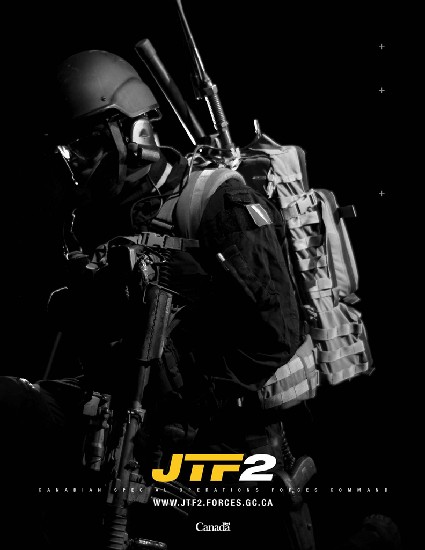
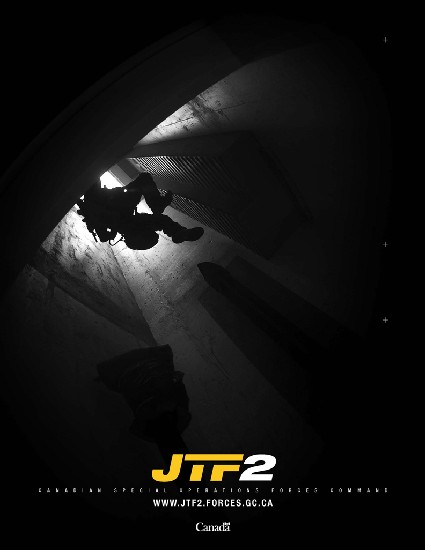
Equipment
Weapons
* Colt Canada C7A2 and C8A1
* FN Herstal P90[10][11][12][13]
* Heckler & Koch MP5A3
* Sig Sauer pistols[2]
Vehicles
* Rheinmetall YAK
* HMMWV (phasing out)
* Jackal MWMIK (phasing in, per March 2009)
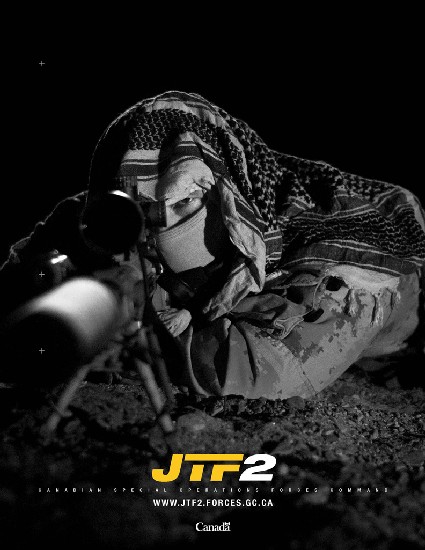
Afghanistan: 2001–present
Approximately 40 JTF2 soldiers were sent to southern Afghanistan in early December 2001, although the Canadian public was not informed of the deployment, following the American declaration of a War on Terror.
Several months later, the Globe and Mail published an image on its front page showing Canadian forces delivering captured prisoners to the Americans, prompting an outcry in Parliament as they were never informed these operations were underway. Vice Admiral Greg Maddison was called before the Standing Committee on Procedure and House Affairs to address claims that Minister of Defence Art Eggleton had purposely misled the public and the government, even failing to inform the Prime Minister that JTF2 had been operating in Afghanistan.
In 2004, an estimated 40 members of JTF2 serving with Task Force KBAR were awarded the Presidential Unit Citation by the United States government for service in Afghanistan. Very little is known on JTF2 operations in Afghanistan, but during a conference the former Chief of Defence Staff, General Rick Hillier, stated that JTF2 is in "high demand" and that they are considered to be "world class." He went on to say that the unit is providing direct support to the Afghanistan government and is targeting the Taliban leadership in southern Afghanistan. He stated that "trying to help neutralize those leaders is a key part of their role and that's what they will continue to do.
